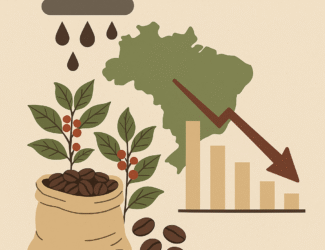
Hot and Dry Weather in Vietnam Pushes Robusta Coffee Prices Higher
Robusta coffee prices climbed on Friday amid growing concerns over hot and dry weather conditions in Vietnam, the world’s largest producer of robusta beans. According to the Dak Lak weather office, the Central Highlands region is forecast to receive limited rainfall between March 21 and 31, raising fears of further crop stress.
On the Intercontinental Exchange (ICE), May robusta futures (RMK25) closed up $18, or 0.33%, while May arabica futures (KCK25) slipped 0.19%, or $0.75. The strength of the U.S. dollar, which reached a two-week high, weighed on most commodities, including arabica coffee.
Despite a slight increase in ICE-monitored robusta inventories, which rose to a six-week high of 4,360 lots, concerns persist over shrinking global production. In contrast, ICE-monitored arabica inventories declined to a one-month low of 777,708 bags.
In Brazil, insufficient rainfall continues to impact arabica crops. Somar Meteorologia reported only 30.8 mm of rain in Minas Gerais—the country’s key arabica-producing region—during the week ending March 15, just 71% of the historical average. Cooxupé, Brazil’s largest arabica cooperative, also noted that high temperatures and below-average rainfall in February are expected to reduce yields this year.
According to the Brazilian Coffee Exporters Council (Cecafé), Brazil’s green coffee exports dropped 12% year-over-year in February, totaling 3 million bags. Earlier forecasts by Conab, Brazil’s national crop agency, projected the 2025/26 coffee crop to fall by 4.4% year-over-year to 51.81 million bags, the lowest level in three years. The 2024 crop estimate was also revised downward by 1.1% to 54.2 million bags.
Meanwhile, Marex Solutions projected a growing global surplus, forecasting that the coffee surplus for the 2025/26 season will widen to 1.2 million bags, up from 200,000 bags in 2024/25.
Vietnam’s February coffee exports rose by 6.6% year-over-year to 169,000 metric tons, according to the General Statistics Office. However, the longer-term outlook remains tight. Drought conditions have already reduced Vietnam’s 2023/24 robusta crop by 20% to 1.472 million metric tons—the smallest harvest in four years. The USDA’s Foreign Agricultural Service (FAS) projects a slight decline in Vietnam’s robusta output to 27.9 million bags in 2024/25. The Vietnam Coffee and Cocoa Association recently cut its production forecast for 2024/25 to 26.5 million bags, down from a previous estimate of 28 million.
Globally, coffee export data presents a mixed picture. Brazil’s 2024 coffee exports rose by 28.8% to a record 50.5 million bags, according to Conab. However, the International Coffee Organization (ICO) reported that global exports in December dropped by 12.4% year-over-year to 10.73 million bags, with total exports for Q4 2024 falling 0.8% to 32.25 million bags.
The USDA’s latest biannual report forecasts a 4.0% increase in global coffee production in 2024/25, reaching 174.86 million bags. Arabica output is expected to rise by 1.5% to 97.85 million bags, while robusta production is projected to increase by 7.5% to 77.01 million bags. Despite the production rise, ending stocks are forecast to fall by 6.6% to 20.87 million bags—the lowest level in 25 years.
In a separate report, Volcafe cut its estimate for Brazil’s 2025/26 arabica crop to 34.4 million bags, down 11 million from its September forecast, citing the impact of prolonged drought. The firm now projects a global arabica deficit of 8.5 million bags for the 2025/26 season—widening from the 5.5 million deficit expected in 2024/25 and marking the fifth consecutive annual shortfall.



